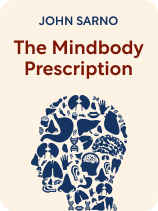

This article is an excerpt from the Shortform book guide to "The Mindbody Prescription" by John Sarno. Shortform has the world's best summaries and analyses of books you should be reading.
Like this article? Sign up for a free trial here.
What is the Dr. Sarno method? How does Dr. Sarno explain the connection between the mind and the body, and how does that influence treatment?
Dr. Sarno’s method involves breaking down the repressed emotions behind physical manifestations of pain. If you understand how this method works, you can start your healing journey.
Read on to learn how the Dr. Sarno method works and how you can apply it to pain treatments.
Understanding the Dr. Sarno Method
In The Mindbody Prescription (1998), Dr. John Sarno explains that the Western world is experiencing an epidemic of disorders characterized by chronic pain with no clear physical cause. However, he explains that these disorders—while genuinely physically painful, and sometimes disabling—are harmless and result from the repression of emotions, particularly rage. He refers to these pain disorders as tension myositis syndrome (TMS). Doctors try to treat these pain disorders as physical problems, but often, their treatments don’t provide any relief. Sarno explains that this is because the problem isn’t physical, it’s emotional—and the key to solving your pain is resolving your emotional tensions. The Dr. Sarno method is one way to resolve these emotional tensions and relieve chronic pain.
Sarno (1923-2017) was a professor of rehabilitation medicine at New York University School of Medicine and an attending physician at the university’s Department of Rehabilitation Medicine. He’s best known for developing the theory of TMS. He’s also the author of three other books on TMS theory, including Mind Over Back Pain, Healing Back Pain, and The Divided Mind.
In this article, we’ll explain Sarno’s TMS theory and how he developed it, the psychoanalytic principles that TMS theory is founded on, and what makes a person predisposed to TMS. We’ll also explain the different ways in which TMS manifests, as well as Sarno’s treatment method. We’ll supplement Sarno’s ideas with scientific and social context as well as tips from other experts on dealing with chronic pain.
According to Sarno, doctors have been diagnosing patients with conditions characterized by seemingly inexplicable muscle pain for over a century. This pain tends to be centered in the back, neck, and shoulders, and it seems to lack a clear physical cause. Because of its prevalence, an entire industry has formed in the United States devoted to diagnosing these disorders—usually as fibromyalgia, myofascial pain syndrome, and fibrositis—and their treatment. Sarno estimates that these issues cost the United States over $100 billion annually.
(Shortform note: Sarno doesn’t specify where these costs come from, but research conducted since the book’s publication suggests that they come from several factors, including the cost of the healthcare itself, missing work, and reduced wages. This research also suggests a much higher total cost than Sarno’s estimate: Based on data from 2008, experts suggest that the total cost of chronic pain in the United States was more than $500 billion. Experts estimate that over 51 million Americans suffer from chronic pain. However, it’s unclear what proportion of the chronic pain in these studies is due to underlying emotional distress as opposed to a different physiologic cause.)
The Mindbody Connection: Tension Myositis Syndrome
Sarno asserts that these disorders are all different manifestations of the same mindbody disorder: tension myositis syndrome (or TMS). A mindbody disorder is one in which mental, emotional, or psychological factors cause physical symptoms. He suggests that TMS is the single most common mindbody disorder in the Western world. (Shortform note: Other common mindbody disorders include hypertension, migraines, impotence, and dermatitis.)
Developing the TMS Theory: The Role of Tension
Sarno continued working with patients suffering from this pain, and he found that nearly 90% of them also suffered from tension-related conditions like heartburn, hernias, irritable bowel syndrome, migraines, and eczema. (Shortform note: Sarno tends to use the word “tension” to refer specifically to emotional and psychological tension and only occasionally applies it to physical muscle tension.) Knowing that tension could induce these physical conditions, he hypothesized that the patients’ otherwise inexplicable pain had the same cause.
He began informing patients that he suspected their pain came from tension, diagnosing them with TMS. To his surprise, the patients who dismissed the diagnosis saw no improvement in their pain—but the patients who accepted it did improve, corroborating his hypothesis. He found this method of treating patients’ pain—through acceptance of the TMS diagnosis—growing more and more successful, and he continued to hone his hypothesis.
Mindbody (Psychosomatic) Conditions: How the Brain Interacts With the Body
Seeing how patients improved in response to his TMS diagnoses, Sarno now had an explanation for these pain syndromes: psychological tension. The pain involved was psychosomatic.
Sarno explains that the term “psychosomatic” has some negative connotations, which is why he uses the synonym “mindbody.” Both terms refer to physical symptoms that are real and result from emotional or psychological factors. The “psych” in “psychosomatic” (and the “mind” in “mindbody”) doesn’t mean a patient is faking or imagining their physical symptoms.
Why Do Repressed Emotions Cause Physical Pain?
This brings us to the physical manifestations of repressed emotions: Because these emotions are intolerable to the conscious mind, the mind goes to great lengths to avoid acknowledging them. It distracts itself from them by forcing the person to focus on what’s going on in their body instead of what’s going on in their head, leading to physical symptoms like pain.
The mind chooses physical symptoms because, unlike emotional distress, physical conditions are socially acceptable. As diagnoses for a physical condition increase, doctors treat it as more “real,” which validates it as a socially acceptable condition. This is why chronic pain diagnoses change over time according to what’s popular (despite the root cause being emotional distress).
How to Treat TMS
According to Sarno’s theory, chronic unexplained pain is a harmless physical manifestation of repressed emotions. Therefore, physical treatments won’t cure TMS. Instead, Sarno explains that the most effective treatment for TMS starts with knowledge: You have to understand mindbody disorders and where the pain is actually coming from in order to treat it. This is why, according to Sarno, many people can cure their pain simply by reading his books or attending his lectures. However, Sarno emphasizes heavily that patients should only take on this diagnosis and treatment after doctors have effectively ruled out the chances of a serious illness.
(Shortform note: Testimonials from people who’ve found success with Sarno’s method support his statement that knowledge is the key to treatment. Prominent media figures like Howard Stern and Larry David have praised Sarno’s method, and there’s a website called thankyoudrsarno.org featuring over 100 success stories and thank you notes to the late doctor.)
Once the patient understands the source of their pain and how the mindbody relationship works, treatment consists of three steps:
Step 1: Reject the diagnosis of a structural abnormality. If you think of yourself as someone who just has a “bad back,” or believe that you’ll have to get used to your pain and deal with it indefinitely, you won’t get better. You have to accept that your condition is harmless. This will get your attention off of your body, which defeats the brain’s tactic of distracting you from your unconscious emotions by forcing you to focus on your physical state.
Step 2: Recognize that your emotions induce the pain. You have to understand that the source of your pain is not physical, but rather that it arises from your suppressed emotions as a way to distract your conscious mind.
Step 3: Accept the nature of the mindbody relationship. Don’t make yourself feel lesser or broken for the symptoms you’re experiencing or the emotions you’re repressing. Everyone has an inner child that’s irrational and emotional. What you’re experiencing is perfectly normal and affects everyone to some degree.

———End of Preview———
Like what you just read? Read the rest of the world's best book summary and analysis of John Sarno's "The Mindbody Prescription" at Shortform.
Here's what you'll find in our full The Mindbody Prescription summary:
- A look at the chronic pain epidemic that's plaguing the Western world
- That the key to solving your pain is resolving your emotional tensions
- Why modern medicine doesn't recognize mindbody connection






